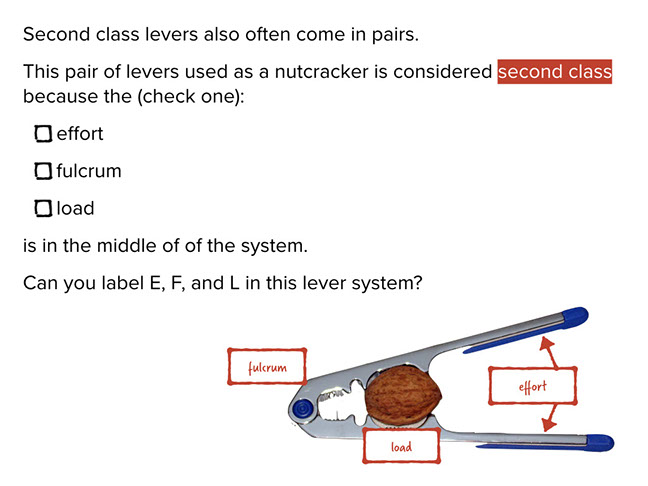Why Is A Nutcracker Second Class Lever
Wheelbarrow, nutcracker and bottle opener are all examples of second class levers. Look at the figures below. Wheelbarrow (second class lever) Nutcracker (second class lever) Bottle opener (second class lever) Example: A man carries a 600N load using a wheelbarrow. What is the force the man applies for the values given in the figure? Apr 02, 2012 Class 3. In class 3 levers the effort is between the load and the fulcrum. In this type of lever, no matter where the force is applied it is always greater than the force of load. The load moves in the same direction as the applied force. Examples: arm, fishing rod.
After operating on the bicycle gearing physics video clip I got to considering about levers. What is a lever? A lever will be a easy machine that investments off displacement for a greater power. It consists of a inflexible club that can be relaxed on a pivot point. There are 3 parts to a Iever that define whát class of Iever it is definitely.
The effort or where the power is used. The insert or where the resistance to shift is. And finally the fulcrum or pivot stage. Depending on where the fulcrum, weight and work are placed defines the cIass of lever.lf the insert and work are placed on the finishes with the fuIcrum in the middle it is a first class lever.
Some illustrations of a first class lever are usually a see found or pliersIf the fulcrum is usually positioned on one end with the fill in the center and effort on the reverse end it is certainly a second cIass lever. Some examples of second class levers are usually a steering wheel barrow or a nut cracker.If the fulcrum will be on one end, with the effort in the center, and the weight can be on the opposing finish this is usually a 3rd class lever. Some good examples of third class levers are usually salad tongs or a angling rod.Right now lets get a look at a 1st class lever that offers the insert 1 unit of length apart from the fuIcrum and the effort 2 devices of length from the fulcrum. To determine the mechanical benefit we can take the input arm distance of 2 over the result arm length of 1 to obtain a mechanised advantage of 2. So in this situation the effort is increased occasions 2.
It takes half the push of the fill to move the lever. This comes at the cost of getting to shift the lever double the distance at the work end of the lever.Let us get a appearance at the dispIacement of the Iever. We observe that the work aspect of the lever offers to shift double the range of the weight aspect of the lever.

We have improved the amount of pressure by 2 at the price of escalating the dispIacement by 2. We can get this by acquiring the circumference of the route of the work and dividing it by the area of the route of the fill. That conclude this movie ideally I gained a such as or membership.
A Course 1 lever magnifies force or range, and can alter path. To image a Course 1 lever, consider the seesaw ór teeter totter, basically a board concentrated on a foundation. The end of the board where the kid sits symbolizes the weight; the additional finish where the adult forces down comprises the work and the foundation that keeps the seesaw gets to be the fulcrum. Another illustration, the mover's dolly, where the pressing down on the deal with is definitely the work, the wheels the fulcrum and the item being shifted is usually the fill, demonstrates this easy machine.
While items such as tires, door holders, bicycle brakes and crowbars make use of this kind of lever as soon as, some gadgets such as scissors and pliers combine two Course 1 levers. Class 2 Levers. This class also magnifies push but changes the magnification by modifying the lever left arm. The Course 2 levers have the load in the center with the drive and fulcrum on either end.
To demonstrate this lever, believe of a wheelbarrow. The farmer's pressing down on the grips represents the effort or power, the wheel the fulcrum and the things in the wheelbarrow the insert. A container opener offers the bottle cover or fill in the center with the push used by the hand at one end and the fuIcrum or pivot point at the additional end. The wheelbarrow, stapler, container opener and doorway demonstrate a one Class 2 lever, while a nutcracker and nail clippers contain two Class 2 levers. The Class 3 lever offers the effort in the middle with the push and fulcrum on either part and magnifies movement. /are-iphones-from-walmart-unlocked.html. Capturing with a broom, (the hands at the top becoming the fulcrum, the hand down the broom getting the work and the dust being transferred, the fill) gives the individual doing the sweeping a better reach in each sweeping motion.
Also, the fishing rod with the angler at one finish as the fulcrum, his left arm tugging the rod the effort and the seafood being caught the load gives the fisherman more movement to land his reward. Other Course 3 levers consist of: spoons, pencils, golfing clubs, canoe paddles, the human being arm, launch and hoe. Twéezers and tongs éach possess two Class 3 levers.